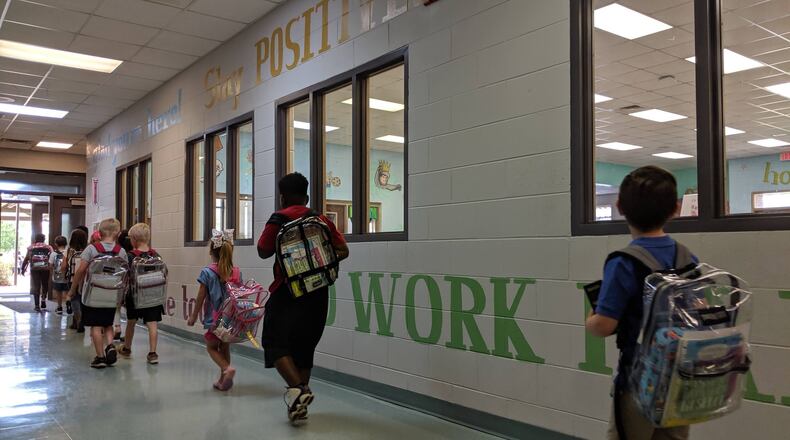When Georgia released the latest scores on its new report card for schools, the results were so bad that two of the state’s top leaders called for change: not at the schools with low scores, but in the report card itself.
“I am a strong supporter of holding schools accountable,” Gov. Brian Kemp said in a press release about the results last week. He added, though, that the scores dropped despite “nearly across-the-board increases in national test scores” and other measures.
It's a fundamental shift in attitude. Kemp's predecessor, Nathan Deal, wanted to take over schools that routinely scored at the bottom of the report card, known as the College and Career Ready Performance Index. He called them "chronically failing." Kemp is instead calling for "refinements" to the index.
Overhauling the report card could have real consequences. People use the scores when deciding where to buy a home, and executives consider them when deciding where to locate plants and offices. More important for students: Officials use them to identify schools where students have fallen behind, so they can bring in help.
Even the man responsible for the new measure, state Superintendent Richard Woods, says it needs to change. He and Deal clashed over Woods' first overhaul of the CCRPI, which was submitted to Washington in late 2017. That rewrite, undertaken to comply with evolving federal law, de-emphasizes test scores and gives extra points to schools for offering things like Advanced Placement courses and classes in the arts, language and PE.
Deal refused to sign it, complaining that it "falls short in setting high expectations for Georgia students and schools."
U.S. Education Secretary Betsy DeVos approved it anyway, and the amended 100-point scale went into effect for the 2017-18 school year. The latest results, for 2018-19, have the average state score sliding 0.7 points to 75.9. (High schools rose 1.7 points to 77, but middle schools tumbled 4.1 points to 72.1 and elementary schools fell 0.7 points to 77.1.)
Woods wants to further de-emphasize the role of tests in the results, and has an ally in Kemp, whose comment was issued in a statement from Woods’ Department of Education.
Matt Jones, Woods’ chief of staff, said there is unprecedented alignment between the two offices — and a rare opportunity to change how schools are graded.
“I don’t want to get into the past too much, but we could have had a situation where the report card was almost 100% test scores,” Jones said. “We still have a measure that’s 70%-80% high-stakes testing. … We have to find a more-balanced approach.”
Why scores fell:
A part of the state report card called “closing the gap” gives schools points for the test scores of their historically vulnerable student populations (minorities, the poor and disabled, non-English speakers), and it was a big reason for the decline in the overall scores, said Dana Rickman, an Atlanta education analyst. “That’s the measure that is really pulling down elementary and middle schools,” said Rickman, the vice president of the Georgia Partnership for Excellence in Education. Either the measure is flawed, or schools are leaving struggling students behind, she said. “Maybe we’re not measuring the right thing, but we need to clear that up and not just assume that we’re measuring the wrong way.”
The governor’s take:
Kemp thinks the report card is inconsistent with other measures, including state graduation rates, state test scores and "national test scores." Kemp didn't clarify which national scores, but a spokeswoman for Joy Hawkins, the executive director of Kemp's Office of Student Achievement, pointed to a ranking by Education Week. The publication ranks Georgia 13th on its "K-12 Achievement Index," but 30th overall when considering other factors, such as reading proficiency, graduation rate and equity in funding. Kemp has heard plenty from educators who want change: Superintendents and teachers frequently complained to him about testing when he and Woods traveled the state on "listening" tours last spring and summer.
The superintendent’s take:
The testing emphasis has been a consistent target for Woods, who lamented in 2018 that he lacked full control over school accountability. "There is excessive authority over the process delegated to entities outside the GaDOE," he wrote in an opinion piece on the agency's website then. The report card "while significantly improved, still does not line up" with public feedback, he wrote. In addition to reducing the influence of test scores, Jones said Woods wants to expand the scale beyond 100 points. Jones said that would allow more nuance in scoring, giving schools partial points for coming close to a goal rather than only full credit for meeting it. A more complex point system would also make it more difficult to assign a letter grade to schools, which is something the Governor's Office of Student Achievement does now and something local superintendents have complained about.
The U.S. education secretary’s take:
The biannual results of the National Assessment of Educational Progress released this week have Georgia slipping in the core skill of reading. The state's scores dropped in the two lower grade levels measured by the federal exam: fourth and eighth. The U.S. Department of Education released this reaction from DeVos, who lamented that 34% of fourth graders nationally (nearly 37% in Georgia) are "below basic" in reading, a measure that she translated to mean: "They can't read." Don't blame students and parents, she said. "Blame the 'experts' who assure us each year that American education is 'doing OK.' That our schools are 'good enough.'"
What’s next:
Woods plans to meet with teachers, parents, business leaders and Kemp to amend the report card. He can make some changes unilaterally, but will need lawmakers’ support for others. In the end, he’ll also need DeVos’ approval. Jones expects the process to take “months” on the state end, but couldn’t predict how long federal approval might take.
CCRPI
The state’s College and Career Ready Performance Index is a tool for comparing schools, that considers these components:
Content mastery — How well students have met the state's standards for English, math, science and social studies, based on test scores
Progress — How much further students have gone since last year in their learning
Closing gaps — How much progress schools make in narrowing academic gaps among subgroups such as minority students, the disabled or those whose first language is not English
Readiness — What a school offers to prepare its students, outside core academic subjects, such as Advanced Placement classes or dual-enrollment classes in which students can receive college credit
Graduation rate — Counted only for high schools
You can check your district or school’s score here: http://ccrpi.gadoe.org/Reports/Views/Shared/_Layout.html
About the Author
Keep Reading
The Latest
Featured


